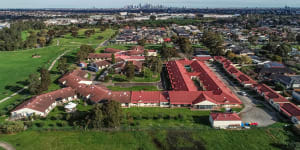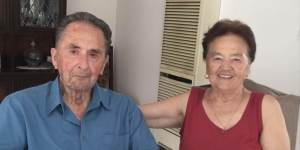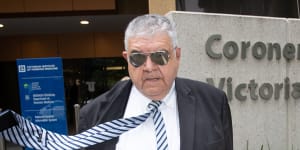A nurse told Erdevicki that there was a dead man in St Basil’s COVID-positive ward. But patients had been moved so many times that the nurse wasn’t sure if this man was Erdevicki’s father,Boro Petkovic.
It was July 2020,and St Basil’s had fallen into chaos.
“After they had put the phone down and said goodbye,I was still wondering:is dad dead or alive?” Erdevicki says.
That astounding phone call was not unique. Eleni Takis received one like it.
Her father,Ilias,a nurse told her,was in room N9. He was dead.
Wait a moment,Takis told the nurse. Dad’s room is D87 – a federally funded call centre in Adelaide had rung Takis the day before to tell her that Ilias was in his room.
Please hold,the nurse told her,and we’ll find out if it is actually your dad who has died. “I was extremely distraught,” says Takis,as she sat by the phone for an excruciating 15 minutes.
Within a month of an outbreak taking hold at St Basil’s,45 of its 117 residents had died after contracting COVID-19. Eighty per cent of residents,and an equal percentage of the 120 staff,got the virus. Another five residents who avoided infection still died – most likely of neglect.
Fifty people died,45 with a coronavirus infection and five of suspected neglect,at St Basil’s nursing home in Melbourne's north last year.
That took the form of residents going unfed,without water and in soiled bedding and clothing,sometimes for days on end. Pressure sores became common at the home because residents who were unable to move went unattended – in one case,for five days in a row.
One experienced nurse told the court a pressure sore she came across was unlike anything she had seen in two decades:“It hadn’t been dressed and it looked nasty,you were able to see into the wound and see the tendons.”
A catalogue of failures
Over the past five weeks,Judge John Cain has heard from 54 witnesses just how ill-prepared the home was for the pandemic’s second wave,which swept over Melbourne last winter.
He heard from counsel assisting,Peter Rozen,QC,who wanted to ask the home’s chairman Kon Kontis and its director of nursing Vicky Kos what they did or didn’t do last July. Rozen never got an answer:both said,on legal advice,that they would not give evidence on the grounds it might incriminate them.
He heard of the pressure the Victorian government’s chief health officer,Brett Sutton,piled onto the home by standing down St Basil’s entire workforce due to fears they were spreading the virus inside the home.
That furloughing of all the home’s staff was ordered despite warnings from two doctors on the ground that it would end in disaster.
And Cain heard of a federal health and aged care bureaucracy unable to manage the unfolding situation despite its untold resources and the ability to simply evacuate residents to hospitals – which happened only when it was too late.
The only solution that bureaucracy offered was to send in its “surge” nursing contractor,Aspen Medical,which brands itself as “the world leader in the provision of healthcare solutions in remote,challenging or under-resourced environments”. And yet,as Aspen explained to the court,it couldn’t even hire junior nurses willing to go into the home – in part because senior nurses were commanding significant hourly wages as the pandemic peaked,while Aspen’s contract with Canberra allowed it to pay only basic rates.
St Basil’s stands out both as our nation’s deadliest coronavirus outbreak to date,but also as the story writ large of Australia’s neglect of those sent to live in aged care – and the incompetence of so many who are meant to help our most vulnerable.
A home away from home
St Basil’s sits on three hectares of land overlooking the Merri Creek,purchased by the Greek Orthodox Archdiocese of Australia in 1993 for $525,000.
The home has a cat,there are chickens,and fruit trees line its gardens. For the residents,it was a home much like those many of them built after settling in Australia from the 1950s on.
Among those who died at St Basil’s were the owners of three fish-and-chip shops. There were two milk bar operators,welders from the Ford factory in Broadmeadows,and seven seamstresses who worked in Brunswick’s long-defunct textile factories.

Not one of the residents who died between July 21 and August 23 last year was born in Australia.
Each was part of the colossal postwar migration from southern Europe;43 were born in Greece,a few hailed from Croatia and Italy,one was born in Egypt to Greek parents,another on a majority-Greek island ceded to Turkey. Despite years of hard slog,usually manual labour,these were people who had lived long lives - the average age of those who died with COVID-19 at St Basil’s was 85 - and raised large families. These were Australian stories of migrant success.
Almost all St Basil’s residents were in the home because they had become too frail to care for themselves,and many were particularly reliant on their carers because their English was not strong. They had turned to the Greek Orthodox Church to care for them in their final years. It was a decision most families would bitterly regret.
The inquest heard of some remarkable failings by St Basil’s managers - but also by the federal government,which has responsibility for aged care.
How severe was the Commonwealth’s failure? To understand,let’s briefly go back to Eleni Takis,waiting on her phone last July to hear if her beloved father Ilias was alive or dead.
When nurse Angela Cox rang to ask whether the dead person in front of her was Ilias Takis,it was not the first call Eleni had received about her father. The day before,July 23,she had been rung by the social worker from the call centre in Adelaide set up by the federal Department of Health.
The ostensible purpose of this centre was to keep families informed. But it had no information to give. What it did have was a script,to be read to people like Eleni Takis,telling them that everything was fine.
Her dad,the social worker told her,“was in his normal room in the dementia section[of] high care at St Basil’s … She told me that she would call me back at 5pm ... with follow-up and answers to my questions. I never received a call back.”
Her father died that afternoon,July 24.
The inquest heard a similar story about the call centre from Nicholas Barboussas,son of 79-year-old Paul Barboussas,whose father was taken from St Basil’s after testing positive for COVID-19 and sent to the Northern Hospital.
On July 25,Paul was in the hospital when Nicholas received a phone call “from the Adelaide call centre,telling me dad was safe in his room. I said my father was in hospital and fighting for his life. There was only silence.”
Paul Barboussas died in hospital the following day.
Boro Petkovic also died,although it took his daughter Jayne days to confirm it was him. “A man was picked up,but I had no idea if it was my dad or not because there was no paperwork. Until I saw him in his coffin,only then I knew it was my dad.”
With medical notes at the home in complete disarray,nurses had to decide for themselves how to care for those who appeared to be dying. Jakov Pucar was 90,and relatives had specifically told one nurse he must not be given morphine. By the time the nurse heard this,Jakov had been administered the powerful sedative.
Then there was the St Basil’s kitchen. In aged care homes,the kitchen is crucial because so many residents need specific diets to keep them from choking.
But even this basic care was beyond St Basil’s kitchen during the outbreak:instead of catering to specific needs,a brief to the coroner states plainly that the kitchen literally ran out of food just as the crisis reached its peak.
“These residents were let down by so many people,systems and politics,” says Rachael Trimbos. Her father-in-law Ilias Trimbos and her mother-in-law Hrisoula died within seven days of each other. The couple were married in 1967 and barely parted until the coronavirus they both acquired in St Basil’s killed them. “They were never given a chance because of their age,” Trimbos says. “If this was a home for children,it never would have been allowed to happen.”
Missed opportunities
From the personal care assistant who first brought the virus into the home in early July through to some of the most senior health bureaucrats in the land,the residents of St Basil’s were let down again and again.
The Secretary of the federal Department of Health,Brendan Murphy,sent in his top nursing officer,Alison McMillan,who declared to him on July 22 that St Basil’s was “fit for purpose”. That proclamation came hours after the first death from coronavirus. They would not stop for another month.

St Basil’s Homes for the Aged in Fawkner.Joe Armao
The inquest heard that Nicholas Hartland,a deputy secretary in the department,had warned that Health Minister Greg Hunt and Prime Minister Scott Morrison were paying attention to what was unfolding in St Basil’s and expected residents to be offered beds in private hospitals – an expectation that did not result in evacuation until 10 days after it was raised.
Texts between the federal and state departments show that by July 12,dozens of beds were available in Melbourne’s best private hospitals for people in aged care with coronavirus. Among the most moving testimony during the five-week inquest was that of Dr Luis Prado,chief medical officer of the Epworth Hospital,who visited St Basil’s on July 24 and immediately ordered residents be given the care they deserved in a hospital.
In sharp contrast to Prado’s testimony was that of Aged Care Quality and Safety Commissioner Janet Anderson. She took the stand and explained that,while her agency had been told about the outbreak on July 10,it did nothing for four days until it was formally notified by the Victorian government.
A coronavirus outbreak was,Anderson told the coroner,not her agency’s job to deal with – it was not the designated “first responder”,after all. “In hindsight,it was a missed opportunity,” she told the coroner.
‘It was completely avoidable’
Branka Lyons is the daughter of Slavka and Jakov Pucar,who both perished in the COVID-19 outbreak.
Married for 64 years,Jakov succumbed to coronavirus on August 11 last year. Slavka died four days later. In her father’s final days in St Basil’s,Lyons told the inquest,she thinks no one at all was caring for him once the “surge” workforce went in. “I don’t believe my dad had anything to eat the whole time they were there. By the time he got to hospital he was a breathing skeleton.”
Lyons– who eventually held a double funeral for her parents – says one of the toughest nights of the whole ordeal was when she finally managed to get her mother out of St Basil’s. Slavka might finally have been free of the home,but Lyons had no idea where she was.

Jakov (left) and Slavka Pucar lived at St Basil’s and both got COVID-19 last year. They died last August,within four days of each other. They had been married 64 years.The Pucar family
“All night on July 31 I had no idea where mum was sleeping or how she was. ... I rang dozens of hospitals and none of them could help me.” Eventually she dialled 000,who said it wasn’t an emergency but they could give her numbers for patient transport companies. “St John Patient Transport was who finally told me where my mum was.”
Lyons taped a conversation she had with Robert McDougall,a carer who had come to St Basil’s as part of the “surge” workforce sent in by the Morrison government. With his permission,she played that tape to the court.
After telling Lyons her father was badly dehydrated and should be in hospital,not at St Basil’s,he described the rest of the home to her.
“People are missing important medications. I lost a man in one wing yesterday and it was completely avoidable,” he said. “I’ve spoken to the Department of Health. I asked them,‘Please shut this place down’. This is a place of neglect … It’s the worst[aged care home] I’ve ever seen in my life.”
He said there were not enough staff;for five wings of the home there were three carers overnight. “I’ve taken photos because I started my shift and people had like three or four trays of uneaten food in their rooms. They’re in soiled bedding - not just soiled,but really bad … People are going mad.”
McDougall had entered the home as part of the workforce led by Aspen Medical,a contracting company paid $44 million by Canberra to reinforce homes with COVID-19 outbreaks by replacing some or all of their staff.
The decision to remove St Basil’s existing workforce because they were all “close contacts” came just weeks after something identical was tried at a smaller aged care home,Estia Heidelberg. There,98 residents and staff had been infected with COVID-19 and 10 residents had died,even after Aspen went in.
At St Basil’s,many Aspen contractors simply refused to return after one shift,saying the conditions were appalling. The company’s deputy head of nursing declined to return after his first shift,fearing he’d lose his nursing registration.
Those senior Aspen staff that didn’t flee tried their best. Among them was nurse Jacinta MacCormack. Even with 41 years’ experience,she was shocked. “I was here in this war zone and I just did what I thought was right at the time,” she told investigators. “There were patients that were obviously malnourished as well as dehydrated ... There was a couple that actually looked quite emaciated. Their hips were sticking out.”
McDougall would later say that even those who managed to survive the outbreak suffered. Among them was Maria Papantoniou,who he found with a catheter that had “the worst infection I had ever seen. The odour was very strong[and] the infection was weeping badly.” An ambulance was called shortly after and Papantoniou was diagnosed with COVID-19 only after she was admitted to hospital.
Another resident,Michael Dimitriadis,died not of coronavirus but of what doctors called “delirium for a duration of 10 days”. He was only taken to hospital after he “removed his suprapubic catheter in a ‘traumatic’ way”. In other words,he pulled it out himself.
‘They became hostile’
The Greek Orthodox Church’s lack of preparation in the lead-up to the catastrophe was a topic of lengthy investigation at the inquest. In the six months before COVID-19 hit,the police report for the coroner states the home paid $1782 for a consultant to devise a coronavirus plan that proved woefully inadequate,and spent just $6952 on personal protective equipment.
Contrast that to what the church had taken out of St Basil’s in revenue in the five years leading up to the deaths:$14.6 million.
MacCormack said when she was sent to help at St Basil’s,she’d expected the existing staff to be welcoming. Instead,“they became hostile” once they realised they were to be replaced:“They were not helpful in any way. They basically shut down and just[wouldn’t tell us] what we needed to know.”

Kon Kontis,former chairman of St Basil’s aged care home,leaves the Coroners Court this week.Jason South
One legal observer who followed the hearing,who asked not to be named so they could speak freely,says it is open to the coroner to make damning findings against St Basil’s. They also believe the Victorian Department of Health may be criticised for its failure to listen to warnings,from its own officers and Northern Health,before ordering out St Basil’s existing staff. And they say the federal government could be criticised for not managing the process better.
A class action against St Basil’s being run by Carbone Lawyers continues,as does a WorkSafe investigation. But ultimately,this may be where the reckoning ends over what happened in the home.
A handful of those who got COVID-19 at St Basil’s survived. Among them is 82-year-old Con Velissaris,who now lives in an East Doncaster nursing home. He recalls asking carers to look after his neighbour,Bill,only to be told forcefully to “go back to[your] room”.
Later,Velissaris was told by another nurse that it was effectively every person for themselves. Velissaris was told to “save himself and stay in his room until[you are] transferred to a hospital to recover”.
“Who knows why he survived and all of these others didn’t? It’s a mystery,” says daughter Mary.
One senior staff member from St Basil’s,Milena Avramovic,the former deputy director of nursing at the home from 2015 to 2020,did appear before the inquest. What she saw unfold there before she was stood down “was chaos”.
The psychological impact of what she saw destroyed her “emotionally,socially,financially”,she told Cain.
“I just hope that all of what happened,tragically,we learn a lesson from this and hopefully it will never be repeated.”